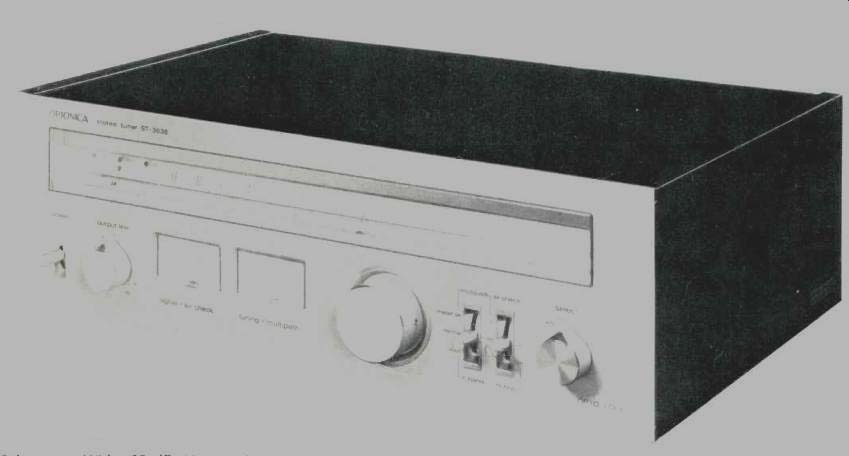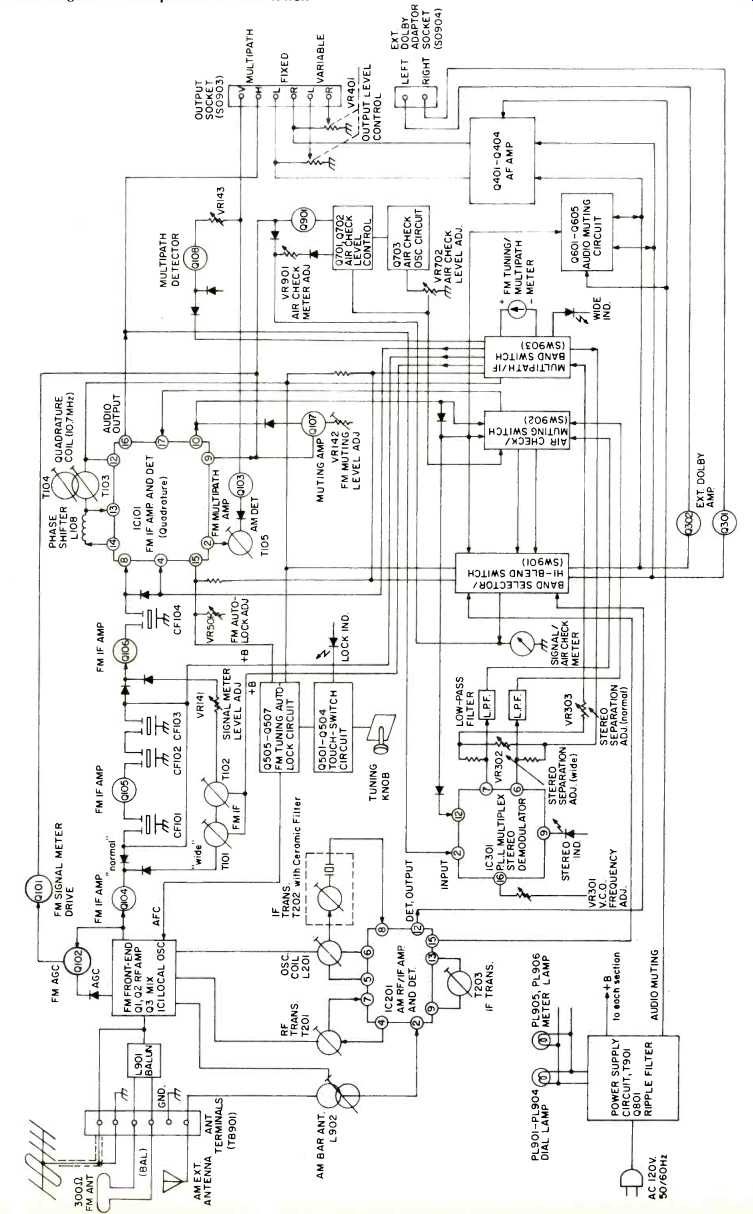
MANUFACTURER'S SPECIFICATIONS:
FM Tuner Section:
IHF Sensitivity: Mono, 1.6 p (9.3 dBf). Selectivity: Wide, 35 dB; Narrow, 80 dB. Capture Ratio: 2.0 dB. AM Suppression: 50 dB. S/N Ratio: Mono, 75 dB. Image Rejection: 120 dB. I. f. Rejection: 110 dB. THD: Wide, Mono, 0.1 percent; Stereo, 0.15 percent at 1 kHz; Narrow, Mono, 0.2 percent; Stereo, 0.3 percent at 1 kHz.
Stereo Separation: 45 dB at 1 kHz.
AM Tuner Section:
Sensitivity: 250 pV/M, internal antenna.
Image Rejection: 60 dB.
I.F. Rejection: 60 dB.
THD: 0.7 percent.
General Specifications:
Audio Output Voltage: FM, 0.65 V fixed, up to 1.2 variable; AM, 0.25 V fixed, up to 0.46 V variable.
Dimensions: 17.4 in. (44.2 cm) W x 5 3/8 in. (14.3 cm) H x 14.7 in. (37.3 cm) D.
Weight: 18 3/8 lbs. (8.5 kg).
Price: $300.00.
Optonica's Model ST-3636 is one of the lowest priced tuners currently available that features selectable i.f. bandwidth in its FM section, not to mention incorporating an unusually fine AM section compared with what's generally available in high fidelity tuner and receiver components. As a basic design, the tuner comes very close to being an "ideal" product in its price category.
The simple, clean look of the front panel is suggestive of a high-quality component. Twin meters are separately framed and illuminated on the lower portion of the panel below the dial scale opening. Each meter serves a dual purpose ... the signal-strength meter doubles as a modulation meter when the built-in air-check test tone is activated, enabling the user to preset recording levels on an associated tape deck, while the center-of-channel meter doubles as a multipath indicator.
Controls to the left of the meters include a power switch and an output level control. A large flywheel-coupled tuning knob is to the right of the meters and two toggle switches are to the right of it. The first switch selects "normal" or wide-band operation of the i. f. section and also selects the "multi-path" mode of the meter. When this setting is used, it is possible to monitor multipath audibly in addition to observing its minimization on the meter as the antenna is rotated.
The second toggle switch turns muting On and Off and activates the internal air-check test tone. A selector switch at the extreme right has settings for AM, FM, FM-high-blend, and FM mono.
The dial area on the ST-3636 is fairly narrow and numbers are set behind the front dial "glass," requiring a shoulder- or head-height installation for easiest observation of the dial frequencies. The FM frequencies are linearly calibrated. The dial area also contains three indicator lights, one for stereo reception, one for denoting "wide band" i.f. mode (when it is selected), and one for "opto-lock" tuning, an AFC-like feature which is non-defeatable (except when holding onto the tuning knob).
Circuit Details
A block diagram of the ST-3636 circuitry is shown in Fig. 1.
The front-end section consists of three dual-gate MOS-FETs and one integrated circuit used for the local oscillator. The i.f. amplification is accomplished by three transistors. In the wide i.f. position, double-tuned transformers are used with one ceramic filter to set i.f. bandwidth. In the narrow setting (normal), four ceramic filters are used to increase selectivity and narrow the pass band. Diode switches are turned On or Off by means of the front-panel, bandwidth-selector switch to determine which of the two signal paths will be followed.
The FM-detector circuit employs a quadrature detector IC, which also provides further amplification and limiting (IC-101 in Fig. 1). IC-301 is the multiplex decoder which includes a phase-lock-loop circuit. Outputs from the decoder are passed through a low-pass filter to eliminate or reduce sub-carrier products. Signals are then passed through buffer/amplifier stages, Q-401 and Q-403, prior to their application to the fixed and variable output terminals of the tuner.

Fig. 1--Block diagram of the Optonica ST-3636 tuner.
FM Performance Measurements

Fig. 2--Mono and stereo quieting and distortion characteristics in the FM
section.
Fig. 3--Distortion vs. frequency.

Fig. 4--Frequency response and channel separation in the FM wide-band mode.
Fig. 5--Frequency response and channel separation in the FM narrow-band mode.
Fig. 6--AM frequency response.
The graphs in Fig. 2 show quieting and distortion characteristics of the ST-3636 when operated in the "wide" mode.
Signal to noise measured 79 dB in mono and 72 dB in stereo, while usable sensitivity was 1.8 pV (10.3 dBf) in mono and 7 pV (22.1 dBf) in stereo. The 50-dB quieting point was reached with input signal levels of 2.7 pV (13.8 dBf) in mono and 37 pV (36.6 dBf) in stereo. Distortion, for a 1-kHz test signal, was 0.09 percent in mono and 0.18 percent in stereo.
When we attempted to repeat these measurements in the "normal" or narrow setting we realized that this particular unit was somewhat misaligned. So long as we kept our fingers on the tuning knob, we were able to keep stereo THD down to around 0.18 percent in the "narrow" mode. When we let go of the knob, THD increased to around the 1.0 percent level. Obviously the "opto-lock" circuit was misaligned with respect to the quadrature detector in our particular sample, and unfortunately, there is no way to defeat this feature unless one holds onto the tuning knob. While we would have expected some increase in THD when using narrow band i.f. setting, this amount of increase was not caused simply by the restricted bandwidth, though we expect this difficulty is not basic to the tuner's design. This experience also serves to show that with a wide band i.f. system, slight detuning (caused by the "opto-lock" AFC circuitry) is not as serious as it is in the case of a narrow-band system. Figure 4 is a plot of frequency response and stereo separation in the "wide" mode and is excellent across the entire audio band of interest (more than 50 dB at 1 kHz). In the "normal" bandwidth mode, separation decreased, as might be expected, and results are shown in Fig. 5. Under these test conditions, separation at 10 kHz measured 32 dB but again, by holding onto the tuning knob and retuning for optimum, we were able to increase this separation reading to 36 dB. Stereo threshold was set at 7 pV (22.1 dBf), while muting threshold was measured as 9.0 pV (24.3 dBf). Selectivity, in the wide mode, measured 83 dB, while in the narrow mode it was exactly 35 dB as claimed. Capture ratio measured 1.0 dB in the wide mode, decreasing to 2.2 dB in the narrow mode.
The i.f. and image rejection were both better than 100 dB. Overall frequency response from 30 Hz to 15 kHz was flat within ±0.5 dB. AM frequency response was exceptionally good on this tuner, particularly in this price class, and is indicated in the 'scope photo of Fig. 6. It was within ±2 dB from 50 Hz to 6 kHz, most unusual for a high-fidelity AM/FM tuner. Listening tests to the AM section confirmed its superiority over other AM tuner sections recently tested.
Use and Listening Tests
Our FM listening tests were confined to the wide-band mode. In that mode, reception quality was quite good, though the tuner's rather low AM suppression, made it mandatory that our antenna be properly oriented for minimum multipath interference. Once that is done, reception quality is indistinguishable from that of tuners costing considerably more than this one. In the owner's manual, we were advised to adjust the built-in air-check tone so that it indicated "60 percent modulation" on the associated meter and to then adjust our connected tape deck for "0 VU" indications on its meters. We found that with most programming this arrangement worked well and allowed us to make recordings from FM stations that nicely fit between the "noise floor" and "tape saturation" levels of our tape equipment. This is a handy feature that eliminates the usual scramble for the record level controls when one begins to record an FM program where levels almost always come as a surprise.
Properly set up, Optonica's "opto-lock" tuning circuitry does go a long way towards making tuning idiot proof, though the sample we tested was not able to deliver all of the excellent performance of which this tuner is capable. It is believed that our sample is the exception that proves we testers are not usually supplied specially selected sets, and we feel that quality control and alignment of all those other Optonica ST-3636s is better than what was applied to our test sample. It should further be pointed out that even with the misalignment, the unit was delivering very high levels of performance in many areas.
-Leonard Feldman
-----------
(Source: Audio magazine, Dec. 1978)
Also see: Pioneer TX-9500-II AM/FM Stereo Tuner (May 1977)
= = = =